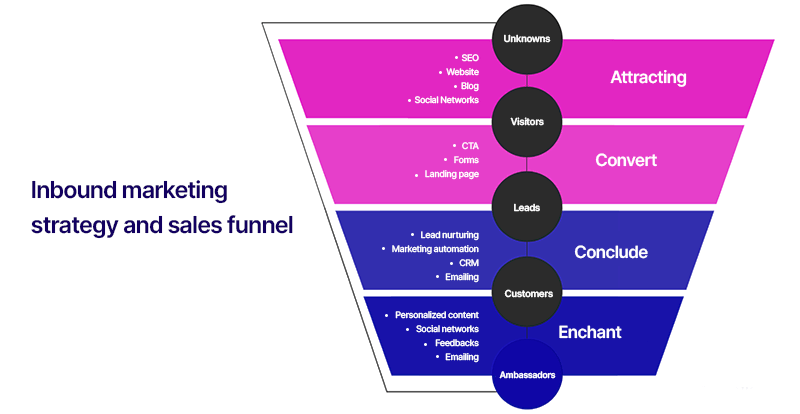Introduction
In this article, Eminence walks you through eight essential steps to create a powerful digital strategy that will set your company apart in the digital landscape.
Step 1: Conduct a Market Audit and Assess Your Online Presence
Before defining a digital strategy, it’s essential to conduct a thorough audit of both your company and the market in which you operate. This will provide a clear picture of your current position and the opportunities available to you, which is the first step in the process of digital marketing.
Assessing your company's current state:
- What are your strengths? Any possible areas for improvement?
- Is your current communication consistent with your positioning and values?
- Do you have an idea of your e-reputation? What is the image perceived by your clients or targets?
- What is your company’s ranking on search engines (SEO)? Have you identified optimization measures?
- What are your current digital tools? Which ones would you like to strengthen to reach your customers?
- Does your website offer an optimal user journey and a satisfactory customer experience?
Analyzing market trends and competitors:
- How is your market evolving? What are the trends?
- What is your positioning?
- Who are your competitors, and how do they position themselves?
- What are their communication channels and messages?
- How do you differentiate yourself from your competitors?
- What are the expectations and needs of your targets?
- Is there any specific legislation regarding your sector of activity?
Creating a SWOT matrix can help you visualize the constraints and opportunities in the market compared with your company's strengths and weaknesses.
A SWOT Analysis is a strategic planning tool that helps identify your Strengths, Weaknesses, Opportunities, and Threats. Strengths and weaknesses are typically internal factors, while opportunities and threats are external.
Both tools provide a structured way to evaluate your company’s position within the market and to identify potential strategies to capitalize on strengths and opportunities while addressing weaknesses and threats.
Step 2: Define the Objectives of Your Digital Strategy
Your digital strategy should seamlessly integrate with your overall business goals, ensuring a unified approach across all channels. By aligning digital objectives with broader business ambitions, you can create a cohesive strategy that leverages all available resources for maximum impact. This alignment is crucial for successful digital marketing strategy development.
Like any strategy, you need to define precise marketing and business objectives. These will help you determine the means and resources to allocate.
What is your ambition?
- Awareness/Visibility: Make your company, products, services, and news known.
- Image: Communicate your company’s values, improve your image.
- Traffic/Lead: Drive prospects to your site.
- Acquisition/Conversion: Reach new customers, generate sales, secure appointments.
- Loyalty: Retain customers, build brand loyalty.
You can use the 5W and 1H questions to help you define these answers:

Use the SMART method to ensure your objectives are clear and achievable:
- Specific: Clearly define your goals.
- Measurable: Set quantifiable KPIs.
- Attainable: Ensure goals are realistic given available resources.
- Relevant: Align with current context and allocated resources.
- Time-bound: Set deadlines for achieving your objectives.
Example: "I want to increase traffic to my website by 5% within the next three months by implementing a Facebook Ads campaign and doubling our publications on Facebook."
Step 3: Identify Your Target Customers and Their Persona
This step is essential because understanding your customers is key to knowing how and where to reach them. Without this knowledge, you risk targeting an unqualified audience that will not help you achieve your return on investment (ROI). This is a vital component of the steps of digital marketing.
Determine your target customers and create their persona:
- Primary target or core target: The priority audience.
- Secondary target: Additional segments.
Once you have drawn up a typical portrait of your targets, determine their buyer personas. There will be as many personas as identified targets.
What is the difference between a marketing target and a buyer persona?
- A target is defined by broad, factual elements such as age, gender, place of residence, income, and other demographic factors.
- A persona goes deeper by encompassing psychological and emotional aspects. It’s a semi-fictional representation of your ideal customer based on market research and real data about your existing customers. A persona includes details such as their background, behaviors, goals, pain points, and motivations.
Example: If your target audience is women aged 25-35 living in urban areas, a buyer persona might be "Emma," a 30-year-old marketing professional who values eco-friendly products, enjoys yoga, and frequently shops online. By understanding Emma's preferences, you can tailor your content and messaging to resonate with her specific needs and motivations.
Why create a buyer persona?
By attributing human qualities to your target, you can better understand their needs and expectations, finding the best way to satisfy them by offering a more personalized and higher quality experience. You will better identify:
- The digital tools your persona uses.
- The social networks they frequent.
- The most favorable times to reach them.
- The media to which they will be most receptive.
- How to address them: tone of voice, content type.
Take care of your ambassadors and advocates:
They are usually your most loyal customers who communicate their satisfaction through word of mouth or directly on social networks. Ambassadors are valuable assets for a company and should be cherished as they convey a good image in a “free” and spontaneous way.
Consider using influencers:
This will obviously depend on your industry, communication trends in your market, and the targets you want to reach. Collaborating with influencers can give visibility, demonstrate a product, or create a buzz within a well-identified community. Select the influencer(s) with whom you may collaborate carefully. An influencer who believes in your product and brand could be a significant asset in your strategy, acting both as a target and as a communication channel.
Step 4: Select Your Digital Communication Channels
During this step, it is important to analyze the digital strategy adopted by your competitors to see what channels seem to be performing well.
- Follow them on their social networks.
- Subscribe to their newsletter.
- Create a Google alert for their name.
- Monitor their e-reputation.
Once you have a broad vision of your environment, your targets, and your resources, you can move on to creating your action plan, which will include various digital marketing activities.
What communication methods should be considered in a digital strategy?

You have a wide range of tools and resources available for each stage of your sales funnel and customer journey.
- Inbound marketing takes longer to set up and requires resources to work over time.
- Outbound marketing can save you time but is more expensive if you opt for advertising.

Your choice will depend on your resources, objectives, and budget. Ideally, combining both approaches is best. While diversifying your digital presence across multiple platforms can maximize reach and engagement, it’s crucial to balance this with the resources at your disposal, ensuring that each channel is effectively managed and contributes to your overall strategy. This is crucial for creating an effective digital marketing strategy.
Step 5: Create an Editorial Calendar for Your Content
An editorial calendar helps organize content distribution and ensures consistency across all platforms. Planning content in advance allows you to align your digital efforts with key business milestones, seasonal trends, and audience behaviors, making your strategy more cohesive and impactful. This is an essential part of the stages of digital marketing strategy.
The editorial calendar should include:
- The target audience to adapt and personalize your message.
- The objectives aimed at: awareness, image, conversion, etc.
- The means you will use: social media posts, emails, newsletters, blog posts, white papers, paid display ads, and ad campaigns.
- The social media platforms where you will communicate: Facebook, Instagram, LinkedIn, TikTok, Pinterest, YouTube, Snapchat, etc.
- The media you will favor: fixed posts, carousels, videos, texts.
- The days and hours of distribution.
Don’t forget to consider all events you can use to communicate: holidays, national days, internal events, new employee arrivals, etc.
Step 6: Create Your Digital Content
Content creation is what sets you apart from your competitors and gives a “human” dimension to your company. Make sure to customize your communication according to the personas you have identified to better reach your target audience and make them feel engaged. This is a crucial part of the online marketing strategies.
Our recommendations:
- Vary the formats to avoid monotony and keep your audience engaged.
- Use storytelling to draw your audience into your world.
- Don’t neglect design; visuals are key to attracting and retaining attention.
- Interact with your community to grow and retain it.
In addition to engaging storytelling and appealing design, make sure your content is optimized for search engines (SEO). This includes using relevant keywords, creating meta descriptions, and ensuring your content is mobile-friendly, all of which can significantly improve your visibility online.
Step 7: Define the Technical, Human, and Financial Resources Required
Take stock of the resources you have available to implement your digital strategy. Don’t underestimate the cost and time required to implement all digital dimensions!
Your human resources:
- Do you have the necessary resources in-house?
- If not, have you:
- Planned to recruit personnel to manage your digital strategy?
- Considered training your employees if they do not have the required skills?
- Evaluated the possibility of using an external provider, such as a digital agency strategy, for all or part of your needs?
- If not, have you:
Your financial resources:
- What budget are you able to allocate for the deployment of your digital strategy?
- Have you:
- Conducted research on the average costs of a campaign?
- Obtained quotes from external providers to assist you at the strategic, operational, or technical level?
- Already made trade-offs by prioritizing channels in order of impact and ROI?
- Determined which channels will generate the most performance?
- Have you:
Effective resource management is key to executing your digital strategy successfully. Prioritize your efforts based on strategic importance and expected ROI, ensuring that both human and financial resources are allocated efficiently to the most impactful areas of your strategy. This is a cornerstone of digital transformation strategy.
Step 8: Measure the Performance of Your Digital Actions
Finally, the last but essential step involves measuring the results of your digital actions and campaigns. When you set your objectives, you likely established KPIs (key performance indicators) to reach. These will determine if your digital strategy has been beneficial and effective and if your actions were relevant. This step is essential to evaluate digital marketing strategy.
Common KPIs include:
- SEO: Ranking on search engines.
- Traffic: Number of visitors, time spent on site or page, bounce rate, number of pages visited, number of sessions.
- Conversion: Revenue growth, average order value, conversion rate, repeat purchase rate.
- Social networks: Number of followers, likes, shares, and comments.
- Mailing: Newsletter subscriptions, open rates, click rates.
We advise setting up dashboards from the start of your digital actions to monitor them regularly and make quick decisions if you find that performance is lacking.
Measuring the performance of your digital actions is not a one-time task; it’s an ongoing process that enables continuous improvement. By regularly analyzing your KPIs and adjusting your strategy based on real-time data, you can stay agile and responsive to changing market conditions, ensuring sustained success over time. If in doubt, consider A/B testing campaigns, for example: this allows you to see what works best with your target audience and adapt your communication accordingly.
What can Eminence bring to your digital strategy?
- Tailored strategy development: We work closely with you to understand your unique business needs, market dynamics, and target audience, allowing us to develop a digital strategy that is specifically tailored to achieve your goals.
- Expert execution and management: Our team has the expertise to execute your digital strategy with precision, utilizing the latest tools and technologies to ensure that your campaigns are effective, efficient, and deliver measurable results.
- Continuous optimization: The digital landscape is constantly changing, and so should your strategy. We provide continuous monitoring and analysis of your digital efforts, making data-driven adjustments to keep your strategy on track and ahead of the competition.
- Comprehensive support: Whether you need assistance with content creation, social media management, SEO, or any other aspect of your digital strategy, Eminence offers comprehensive support to help you maximize the impact of your online presence.
By partnering with Eminence, you gain access to a team dedicated to driving your business forward in the digital age. Our goal is to help you unlock the full potential of your digital presence, ensuring that your strategy not only meets but exceeds your expectations. Let us be the catalyst that propels your business to new heights in the digital world.
Conclusion
In an ever-evolving digital landscape, your strategy must be both robust and flexible, capable of adapting to new trends and customer behaviors. While crafting a powerful digital strategy involves multiple steps - from market analysis to content creation and performance measurement - the real challenge lies in executing it effectively and continuously optimizing for success. This embodies the essence of the best digital marketing strategy.
This is where Eminence steps in. We are more than just a digital agency; we are your strategic partner in navigating the complexities of the digital world. Our team of experts is here to guide you through every step of the process, from the initial planning phase to ongoing optimization, ensuring that your digital strategy is not only aligned with your business objectives but also positioned for long-term growth.
Frequently Asked Questions
How do you present a digital marketing strategy?
Use clear visuals and data, describe objectives, target audience, channels and key tactics. Highlight key performance indicators and expected results to show the impact.
How do you create a digital marketing strategy?
Start by defining your objectives, considering your audience, choosing the proper channels, planning content, building a budget and measuring results.
What is a digital marketing strategy?
It's a plan that explains how to use online channels and digital tools to reach marketing objectives, attract audience attention and increase sales or awareness.
What are the three main elements of a digital strategy?
Defining clear objectives, choosing the right digital networks and analyzing data to evaluate success and improve performance.





